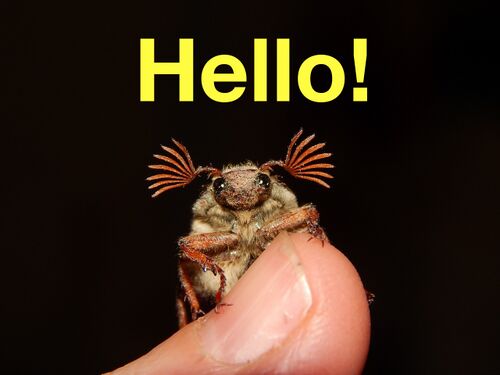LFS:APBI490 Insect Biography
Prepare an extension and outreach document (e.g. one-page handout, brochure, card) or other outreach material (e.g. audio/visual, interactive game) to effectively communicate the following information to your chosen audience (e.g. children, high school students, farmers, general public, etc) about an insect found within agroecosystems:
- Insect common names and scientific names, and translations when available/appropriate
- Insect life history
- Cultural history of the insect
- Why should they care about the insect
- Research status
- Where they can go to learn more (e.g. links to additional information)
If your chosen format will not accommodate all of the required info, include a separate document with the "additional information."
Additional instruction and support will be provided in class.
Science Communication

Tips
- Identify your audience
- What does that audience need for the story to be accessible?
- Key messages
- What are the three or so thing you absolutely need to get across to the audience
- Metaphors & analogies
- Think of quick ways of bringing people into the story.
- Someone-doing-something-for-a-reason
- Harness the power of storytelling with characters
- Structure your story
- Writing a hook and structuring a beginning, middle & end
Examples
- This American Life: Somewhere Out There
- Radiolab: Octomom
Resources
- Book: Escape the ivory tower, Nancy Baron
- The Alda Center for Communicating Science
- Book: If I understood you, would I have this look on my face? Alan Alda
- Compass: The Message Box
Digital Tools
Photos
- The Basics
- Always check the resolution, especially if you're using stills in video. The frame for a video is 1920 x 1080
Audio
- Podcasts can be a fun way to introduce people to your insect
- Audio and Podcasting resource page
- Audacity audio editor is a free audio editor you can use
Infographics
- Infographics take data and information and present it in visually engaging ways
Services
- Adobe Express
- Canva
- Infogram
- It also let's you generate dynamic charts
- And my favourite: Piktochart
Beware the Prezi syndrome. Focus on content.
Examples
Video
Equipment
- Smartphones
- LFS Learning Centre
- UBC resources
Getting the best shot
- Stabilize the camera with a tripod or DIY improvisation
- The 'rule of thirds'
- Lighting
- Using sunlight to your advantage
- Three-point lighting
- Thinking of your background
- Smartphone specific tips
- Make sure to have enough memory and that phone is charged
- If necessary, delete older photos, videos, apps
- Go into Airplane Mode (preserves battery and prevents interferences on the audio)
- Shoot horizontally not vertical (think of cinema and your eyes)
Editing
- Camtasia allows for basic editing
- Free download for UBC community
- iMovie & MovieMaker
- Adobe Premiere Pro is available for more sophisticated projects (free for UBC staff and faculty)
- On campus facilities (Learning Centre Media Lab is also available)
Formats
Video Formats
- Screencasts with Camtasia (available in Canvas)
- Whiteboard videos & Videoscribe
- Whiteboard thesis
- Video essay
Non-Video Formats
- Podcasts
- Timelines
- Dynamic websites
What is a digital story?
At its most basic, a digital story can be any story you tell using digital tools.
It is synonymous with first person narrative stories accompanied by a slideshow,
but it can extend much further beyond that, encompassing any and all digital tools.
- StoryCenter
- Digital Stories Canada
- Faculty of Education's Scarfe Sandbox
So, why tell a story?
Narrative stories help people connect to information in different ways. It can appeal to their emotions, it can help them identify with the story, and it can make it more memorable. Science communication is no different. Telling people stories about science can help them understand it more clearly and recognize its impact on their lives.
UBC TerreWeb video, as mentioned in the NY Times.
Copyright and Sourcing Media
Copyright basics
- UBC Copyright office
- Your copyrighted works
- Other people’s copyrights
- Fair dealing / fair use
Creative Commons resources
- Learning Centre wiki page
- Photos
- Take your own!
- Unsplash
- Pixabay
- Wikimedia Commons
- Icons
- Music
- Video, etc
Sharing
- UBC's Kaltura
- integrated with Canvas
- you should not be posting videos directly to Canvas. Much better to use Kaltura or, if it's appropriate, another platform.
- YouTube: public / unlisted / private
